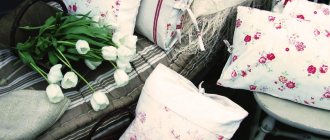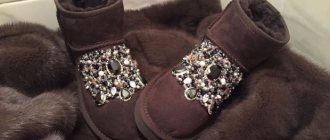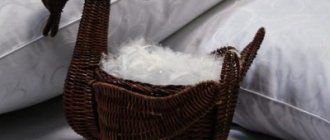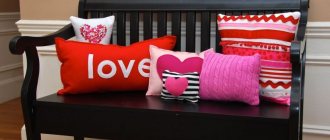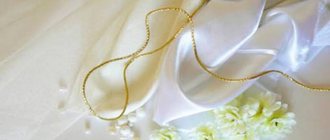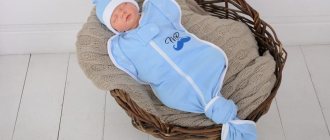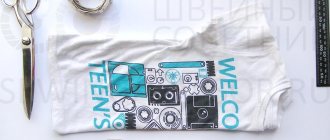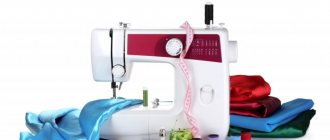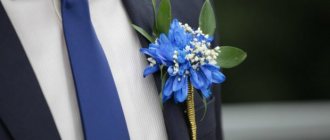Deciding on the sizes
Of course, you should start by determining the size of the pillow. To make a product “for yourself” as accurately as possible, use the following recommendations.
- The height of the pillow is a calculated value. Depends on the size parameters of the person for whom it is intended. Measure the distance from the ear (visually a vertical line lowered from it to the shoulder) to the edge of the shoulder. The resulting value will be the optimal height of the product.
- Analyze the moment in which position you prefer to spend most of the night. If your favorite position is sleeping on your back, the pillow should be slightly lower and denser. For those who prefer to sleep on their stomach, a soft, low pillow is suitable.
- Another factor to consider is the characteristics of the mattress. The harder and denser the mattress, the lower the pillow under your head should be.
Reference! Making a pillow with your own hands is an excellent opportunity to try it on and ultimately adjust the product to your parameters as much as possible. Do not immediately sew up the hole through which you insert the filler. Tack it with running stitches, test the pillow by adding or subtracting the amount of filling. Once the ideal result is achieved, the hole can be stitched.
Deciding on the form
As for the shape, it all depends on your personal preferences. For the head option, a regular - classic - square or rectangular head is suitable. For travel - in the form of a bagel. For pregnant women - in the shape of a banana or the Latin letter U. Another newfangled option is a hugging (or body) pillow, which can be made in the shape of the letters G, I, C, P or G and be the size of a human being.
What materials to use
You should not be afraid of the task at hand. As practice shows, it is possible to sew a product without professional skills and in-depth knowledge of sewing. The main thing is to choose the right materials and scrupulously approach the task at hand.
For a confidant
Teak is still considered the most optimal fabric for making bedsteads. This option is especially relevant if you intend to fill the pillow with feather or down. If any of the artificial materials will be used as a filler, calico, ranfors, linen, poplin, satin, polysatin, jacquard, flannel, polycotton, knitted fabric, microfiber, percale, polyester, knitted velor can be used to sew the bedstead.
As a filler
Down, feather and wool, although they belong to a series of natural fillers, are still not the best option. These materials require regular cleaning, are excellent dust collectors and a favorable environment for the life of dangerous microorganisms that cause and aggravate allergic reactions. In addition, they quickly lose their shape.
In view of this, it is better to give preference to modern artificial materials. The following can be excellent hypoallergenic, springy fillers:
Hollofiber Practical, durable, springy material that is easy to care for. Siliconized fibers twisted into “springs” quickly restore their original shape after compression. Safe and hypoallergenic. Characterized by excellent thermal insulation and ventilation. Washable.
Holofiber filler.
Comforel Ball-shaped siliconized “granules”. Compared to holofiber, it is softer and less durable. Nevertheless, it holds its shape well, retains heat and is well ventilated. Does not accumulate odors. Washing is allowed.
Silicone “Sheet” holofiber. Hypoallergenic, well ventilated material. May have different degrees of density.
Synthetic fluff Soft, springy filler. Retains heat and is well ventilated. Easy to use, great material.
polystyrene Foamed polymer with a crumbly structure (in the form of miniature balls). An unusually lightweight material consisting of 98% air. A distinctive feature of products filled with expanded polystyrene granules is their neutrality to external temperatures (does not heat up from the body). Belongs to the category of semi-rigid fillers. The only inevitable drawback is a slight rustling sound from the friction of the granules against each other.
Reference! Synthetic winterizer is not recommended as a filler. Hypoallergenic and budget synthetic padding polyester is not elastic enough, holds its shape worse and quickly becomes loose.
Variants of the listed fillers, as a rule, are easy to purchase even in small cities (or on the Internet).
Unusual fillers
Buckwheat husks and cherry pits Natural fillers with a therapeutic effect. They do not harbor dust mites, which is important. The downsides include the rustling sound the pillows make and difficulty in cleaning. Products cannot be washed. Pillows with buckwheat husks and cherry pits are not intended for regular night sleep, as these fillers are not orthopedic enough.
Herbal pillows A hot topic for aromatherapy lovers. Before you start creating a grass pillow, you should familiarize yourself with some important nuances. For example, keep in mind that fragrance is a kind of medicine and should be selected carefully. Since the herbs themselves do not hold their shape well, sedge, fireweed fluff, heather or straw are used as a base. Herbs must be fresh and well dried. The service life of such pillows is 1-2 years, subject to storage rules.
Orthopedic fillers
Orthopedic pillow fillers include natural latex, polyurethane foam and viscoelastic foams (memory type). In principle, if you wish, you can even find such fillers (sheet versions) on sale. It is unlikely that it will be possible to depict an ergonomic wave-like or massage version (although for those who are especially persistent, nothing is impossible), but a rectangle or square is quite possible.
For pillowcase
The range of fabrics from which you can make a cover or pillowcase is huge - for every taste and budget.
Chintz
The most affordable option. Has an incredibly wide variety of colors. Hygroscopic material - perfectly breathable and absorbs moisture. At the same time, it is not durable enough, is not resistant to abrasion, and shrinks when washed (before cutting, it is better to soak a piece of fabric in water at the temperature in which you will subsequently wash the pillowcases).
Satin
A more expensive, practical, comfortable option. Beautiful and durable fabric.
Natural silk
Expensive, luxurious material with thermoregulating properties. Quite demanding in care.
Poplin
A noble fabric created from cotton and silk fibers. More durable and less fussy than 100% silk.
Linen
Linen for bed linen often implies the presence of cotton fibers (for softness). Very practical and durable material. The disadvantages include high creasing and difficulty in ironing.
Bamboo
Durable fabric with properties typical of viscose materials. It is not natural, although it is produced from individual parts of the bamboo plant.
Velor and terry
Modern, original, durable fabrics, warm and soft. They absorb moisture well and do not slip.
Tools
In addition to having the necessary materials, you will need the following tools:
- threads in the color of the fabrics
- measuring tape, ruler
- cutting scissors
- tailor's pins
- sewing machine
- zipper length 25 cm
- pattern paper and pencil
- sharpened soap or chalk
Pillows and mattresses made from nettle stems
Making a healing mattress and pillow from winter nettle stems will take very little effort and time. What is needed for that:
1. It is not at all necessary to cut winter stems near the root. You can only break the part of the stem above the snowdrift.
2. Clear the stem of leaves and seeds, if any are still preserved. Do not throw it away under any circumstances!!! The leaves are already old for nutrition, so you can make a pillow out of them or sew them into a bag and simply apply them to sore spots. But the seeds are a powerful biological food additive. Its effects are equivalent to ginseng root. Even dried on the root, they are suitable for food.
3. Dry everything.
4. Do not break the stems! Carefully make the mattress. For these purposes, I recommend taking thick fabric. Sew a large bag and carefully lay the straight stems along it, alternating the butt with the crown and distributing them evenly. Sew up the hole. For a pillow, you can take only the tops of nettle stems, first knead them.
This is how you can quickly make yourself a healing bed from a mattress and pillow. But that is not all! After some time, you will find partially processed nettle fibers in the mattress.
Instead of spending a lot of money on pharmaceuticals, it is better to spend a lot of time making such beds for yourself, and change them once a month, when the time of year allows (spring, summer, autumn - from fresh; in winter - from ready-made trust).
For those who have already started obtaining nettle fibers at home: a mattress and pillow can be made from firewood, which remains after processing.
If you collect herbs yourself, think positive thoughts so that your good energy will enhance the healing properties of the plants. In the old days, it was customary to accompany any good deeds, especially those aimed at healing, with prayers and songs. It is better to collect herbs away from highways and city smog.
Carrying out work step by step
If you have stocked up on all the necessary materials and tools, you can start making the pillow. The algorithm for performing the work is as follows.
- Making a paper pattern. The dimensions and shape of the patterns depend on your preferences and the chosen model. Alternatively, you can take ready-made parameters from the Internet, or use someone else’s experience (pattern).
- Transferring the finished pattern onto the fabric. To avoid displacement, it is better to pin paper patterns to the fabric with tailor's pins. The pinned patterns are traced along the contour with a sharpened soap or cutting chalk.
- Reveal the details. The parts are cut out taking into account seam allowances (for stitching). The size of the allowance is 1-1.5 cm.
- Basting and stitching pillow parts. Pieces folded face to face are basted or pinned with tailor's pins (to avoid displacement during the stitching process). Sew down the parts, leaving the hole for inserting the filler free, and turn the napkin inside out onto your face.
- Filling. The pillow is slowly filled with filler, distributing it evenly. As mentioned above, the hole for inserting the filler should not be filled in immediately. It is better to “grab” it manually using running stitches (or sew in a zipper) and test the product for several days or nights. You may need to increase or decrease the amount of padding to achieve optimal comfort.
Manual processing
The preparation is the same as for processing products in an automatic machine, but the process takes more time and creates inconvenience for the housewife. It is important to know all the details in order to correctly assess your strengths.
READ ALSO: Rules for washing a down jacket in an automatic machine: useful tips to avoid damage to the product
How to proceed:
- fill the bathtub with warm water, add liquid soap or washing gel, essential oil (10 drops), ammonia (2 tbsp.), foam the liquid;
- be sure to wear a medical mask to protect your respiratory system;
- carefully pour out the feathers, making sure that there are as few filler particles on the floor as possible. If there are a lot of pillows, or the volume of the product is large, then you need to wash it in parts so that there is somewhere to lay out the wet feathers;
- You need to soak contaminated fluff and feathers for about two hours, stirring the mixture periodically;
- All that remains is to carry out the most difficult step - rinsing the feather filler. A regular colander is suitable for washing and spinning. The procedure takes a lot of time; you need to think about where to dry clean feathers. It is important to completely remove large particles before opening the bathroom drain, otherwise it is easy to clog the drain;
- The wet filler is laid out in a thin layer and dried until all the moisture has evaporated. You cannot refill a pillow with raw materials that have not dried out: mold quickly appears and the process of rotting begins;
- The process is labor-intensive and lengthy; the housewife has to work with a large mass of feathers. Particularly dangerous are small particles of fluff that fly around the bathroom, get into your eyes, stick to wet hands, but at the same time slip through the holes of the colander when rinsing. If the automatic washing machine does not work for some reason, then it is better to have the pillows dry cleaned by specialists than to spend a lot of time, nerves, and effort washing, rinsing, and drying the filling manually.
After washing, the diapers are taken out and wrapped in an unnecessary sheet for half an hour to remove excess moisture. It is advisable to have two or three old pieces of fabric so that you can replace the sheet with a new, dry one a couple of times within 30 minutes. A simple operation facilitates the drying process and reduces the time allotted for the operation.
Learn how to remove moment glue from clothing, skin and other surfaces.
What to do if condensation forms on the toilet cistern? Read useful tips at this address.
On the page https://poryadok-v-dome.com/sovety/kuhnya/kak-varit-klubnichnoe-varene.html, read the information on how to make thick strawberry jam.
DIY travel pillow
If you travel often and for a long time, then you are familiar with the feeling of discomfort experienced every time you try to take a nap while sitting in a waiting room, in a car, bus, train or plane. Why not buy (or make your own) a travel pillow? It's actually very simple and won't take much time.
Travel pillows are usually shaped like a bagel or a horseshoe. It is this option that most comfortably supports the neck and head during “sedentary” sleep. To make such a pillow, use natural or mixed pleasant, non-slip fabric for the cover (usually fleece, flock, spandex, less often - polyester, nylon, cotton, linen, satin) and artificial filler (usually holofiber).
The principle of performing the work is similar to that described above.
- Making a paper pattern.
- Transfer the pattern to the fabric folded in half (face to face).
- Cut taking into account allowances.
- Sweeping or chipping parts.
- Sewing parts (don't forget to leave a hole for inserting filler!).
- Turn the product inside out and fill it evenly with filler.
- Sealing the hole.
Machine washable
Important details:
- after the preparatory stage, set the delicate mode and speed from 400 to 600, a temperature of 30 degrees is suitable for washing the pen;
- then lay out the feather in several old quills, sew up the covers, and place them in the drum;
- In the powder compartment you need to add a few drops of ammonia or oil with antiseptic properties - tea tree ether. The best option is to use environmentally friendly washing powders and gels;
- the feathers inside the pillowcases won’t bunch up if you add a couple of old unnecessary things, which you don’t mind disposing of later. Some people put tennis balls inside their pillows so that during the washing process the items will hit the feathers and break up clumps;
- It is fashionable not to disassemble small pillows and pour the filling into another cover. It is enough to select a gentle wash mode and a low temperature (30 C is enough). An important point is to rinse the small pillow well. You cannot spin the product for a comfortable sleep at maximum speed.
READ ALSO: How to clean and wash a jacket at home: rules for machine washing and methods for manual cleaning
Decorative pillows
All of the above principles apply equally to the production of decorative pillows.
Recommended fillers - holofiber, comforter, synthetic down, polystyrene foam granules, foam rubber (polyurethane foam), foam rubber crumbs.
The variations in sizes and shapes are limitless (you can come up with your own or choose any model you like from the Internet).
There are many more samples of materials for sewing pillowcases than for models for sleeping. Since the purpose of these pillows is to decorate the interior, the materials for pillowcases are not subject to very strict requirements in terms of naturalness and hygroscopicity. Any theme would be appropriate here - from furniture flocks and tapestries to natural and artificial fur, as well as patchwork and the use of accessories.

